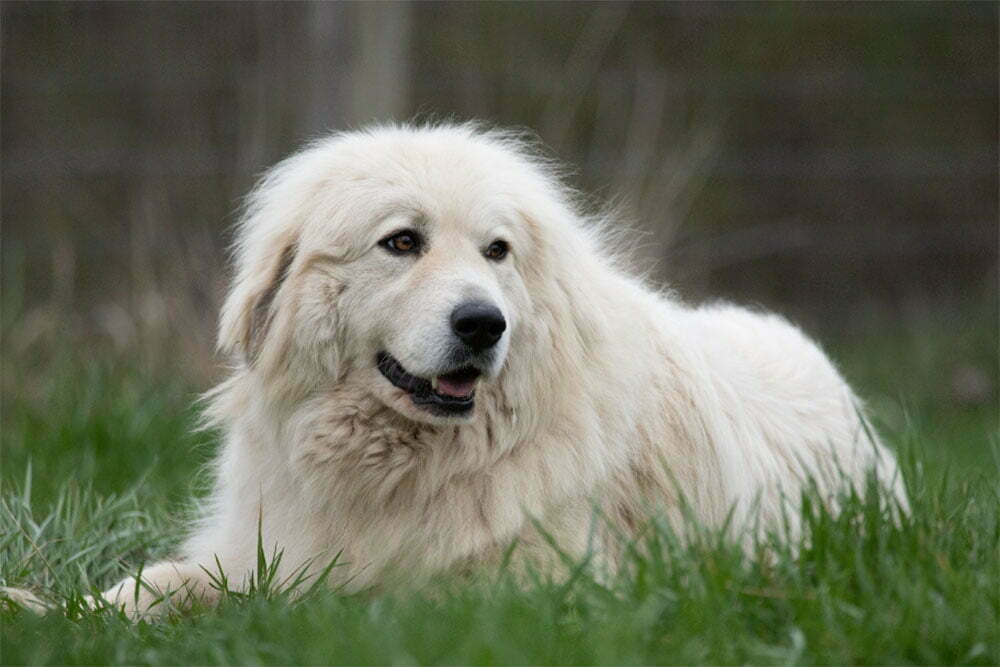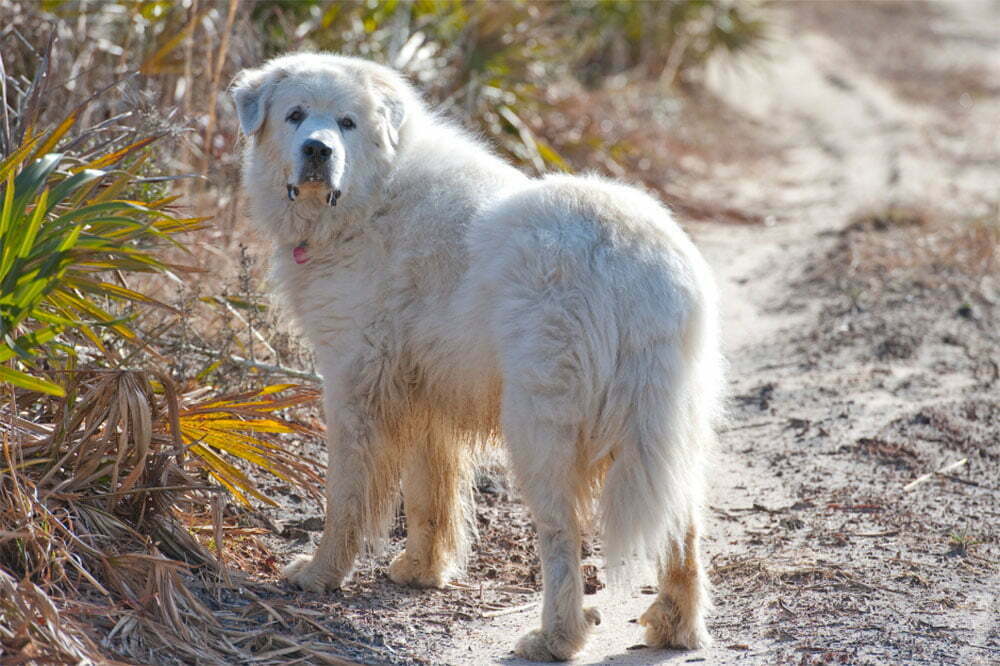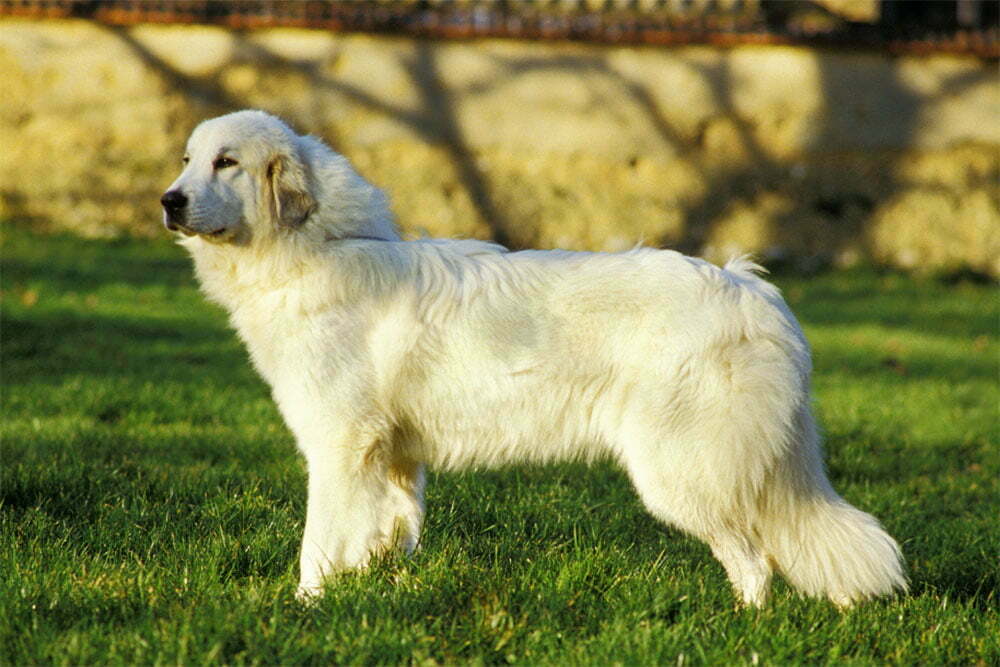If you’re currently looking to purchase your own dog and considering getting a Great Pyrenees, this is the article for you!
Even though introducing a four-legged pal into your family is sure to bring plenty of cuddles and playtime, a dog is a long-term commitment, so it’s super important that you make sure that you are making the right choice.

If you’re already familiar with the Great Pyrenees breed, then you’ll know that they’re characterized by a very big, fluffy coat and a mellow, almost “serious” attitude! Once guardians of the mountains of the Pyrenees in Spain, the modern-day Pyrs make a loyal and steadfast companion but is one right for you?
This is where we come in to lend you a helping hand! Below, we’ll be taking a deep dive into this working breed so that you can decide whether or not you feel the breed is right for you.
In this article, we cover all bases from physical characteristics to temperament, dietary requirements to care needs. Ready? Let’s jump in.
What is the Great Pyrenees dog?
Often described as being elegant and regal, the Great Pyrenees is a type of giant-breed dog that has a large, thick coat that helps to protect these large dogs from the elements, particularly considering the fact that they were first bred to work as guardians of sheep and other flocks of animals at risk of being hunted in the Pyrenees mountains.
So, as you might have already guessed, the Great Pyrenees are a breed of dog built to withstand adverse weather conditions.
These strong mountain dogs can stand at a height of as much as 32-36 inches at the shoulder and can often weigh more than 100 pounds – which is around the size of a teenager or small adult.
They are mainly characterized by having a zen-like, relaxed demeanor and a mellow nature that will see a Pyr kicking back and observing its surroundings rather than playing and running around.
However, as quick as a flash, these large giant-breed dogs can spring into action and move with lightning-quick agility that is impressive to the eye.
Moreover, these strong working breed dogs will meet predators head-on without fear and fight to protect themselves, their family, and their territory with steadfast courage.
Plus, as we said above, seeing as the Great Pyrenees dog was initially bred to be able to withstand the often harsh environment of the Pyrenees mountains (and other types of mountains), the Great Pyrenees dog has a weatherproof coat that can protect against extremely harsh weather conditions, especially snow and rain.
Physical traits of the Great Pyrenees dog
The Great Pyrenees is a large, muscular dog with a double coat. The outer coat of the Great Pyrenees is thick and wiry, which helps ensure that the dog stays warm and protected from outside elements, such as cold weather.
On the flip side, the inner coat of the Great Pyrenees dog is usually thick yet soft and easy to brush through.
As for the color of a Great Pyrenees dog, the colors of the coat can vary, although the most common colors seen on a Great Pyrenees are white, white with patches of brown or yellow, as well as gray and tan.
The nose of a Great Pyrenees is usually black, the eyes are dark brown in color, and the ears are usually triangular-shaped and naturally flop forwards in a sloping fashion. More often than not, the tail of the Great Pyrenees dog is long and fluffy at the end and can reach all the way to the dog’s hind legs.

If you’re buying a Great Pyrenees, it is very important first to consider the size of this breed of dog and the potential implications that this may cause.
To give you an idea of the size, an average Great Pyrenees dog will usually be anywhere between 27 to 32 inches in height. However, in some rare instances, there have been recordings made of Great Pyrenees male dogs reaching upwards of 36 inches in height.
As for the weight, a Great Pyrenees male dog will usually weigh in at around 100 pounds, and this figure can quite easily work its way up into the 110s.
On the other hand, the average female Great Pyrenees dog is usually slightly smaller than the Great Pyrenees male dog and can reach an average height of 25 to 29 inches. However, again, the height of a female Great Pyrenees dog can sometimes reach slightly higher than this.
Not only that, but due to the slightly smaller size, the weight of an average Great Pyrenees female dog usually falls around 85 pounds and very rarely makes it to 100 pounds or more.
As a side note, it’s very important to keep in mind that if you do decide to introduce a Pyr to your family, then you will need to make sure that you are regularly grooming your Pyr. Otherwise, you’re going to find that their coat will become tangled and knotted, and full of tangles – which can easily and very quickly become uncomfortable and painful.
Personality traits of a Great Pyrenees dog
As the Great Pyrenees dog is specifically bred to be a working dog capable of herding flocks of sheep and warding off predators, it should be no surprise to hear these hard-working dogs are characterized by their serious and relaxed attitude.
They are very calm and well-mannered to humans and are generally considered to be very mellow, affectionate, and gentle to their owners.
In addition, Great Pyrenees dogs are known for their affinity with children and for being very kind and patient with them – so they make absolutely wonderful family dogs.
Though prone to short bursts of energy, Pyrs are not necessarily the type of dog to want to run around and play all day.
Instead, these intelligent dogs usually prefer to be left to their own devices throughout the day and have an undeniable independent streak that can sometimes make it quite difficult to train. Pyrs are also known for having a natural instinct to bark at strangers and potential threats.
In addition to all of this, even though the Great Pyrenees dog is known for being reserved in nature, if the need arises, this large-breed dog will not hesitate to defend both its territory and family, so it should also come as absolutely no surprise to hear that these dogs also make fantastic guard dogs, as well as companions.
All of this combined makes the Great Pyrenees dog a very friendly and enjoyable dog to have, and thrive best in quiet, orderly households with a relaxed atmosphere and plenty of routines.
As we’ve already mentioned, Pyrs love their alone time and love to just kick back and observe the world around them, so they might not be a great fit for a more lively household/family environment.
As a side note, due to the protective, territorial sides of Great Pyrs, its highly important to keep in mind that if you do decide to add one to your family, then you will need to regularly give your Pyr socialization with both humans and dogs, as this will help to prevent overly protective behavior from your Pyr that could potentially become dangerous if your Pyr feels that their territory or family members are being threatened and need to be guarded.
Health traits of a Great Pyrenees dog
The Great Pyrenees dog has a general lifespan of between 10 to 12 years (although keep in mind that in some instances, this can be higher or lower) and is generally considered a very healthy, hardy breed of dog.
Suppose you do decide to get a Pyr. In that case, you should note that Pyrs are at a higher risk of developing minor health conditions, such as cataracts, skin issues, panosteitis, OCD, entropion, and osteosarcoma.
In addition to these health issues, Great Pyrs can also be susceptible to developing spinal muscular atrophy, otitis externa, and gastric torsion. However, these are far less common in Great Pyrenees.
Nevertheless, due to the higher risk of developing these potentially debilitating conditions, it is strongly recommended that Pyrs are taken for regular examinations at the vets so that any health conditions can be detected as quickly as possible and treated in the earliest stages.
However, as we’ve already said, these particular health conditions are relatively uncommon in Pyrs, especially those who are cared for properly, fit, and healthy.
In addition to this, Great Pyrenees are unlikely to develop any form of cancer. However, it is recommended that Great Pyrenees are taken for regular check-ups at the vets, as this will mean that any potential health conditions, such as cancer, can be picked up sooner rather than later.
How long does a Great Pyrenees dog live?
Even though the lifespan of a Great Pyrenees dog will no doubt vary, the average lifespan of a Great Pyrenees dog is around 10 to 12 years, which doesn’t stray too far from the average lifespan of a dog is 11 to 13 years.
If you’re considering buying a Pyr, then the best way to increase the lifespan of your Great Pyrenees dog will be to make sure that you are giving your Pyr a healthy diet, plenty of regular visits to the vets, as well as making sure that you’re giving your Pyr plenty of exercise.
In addition to all the basics, another way you can make sure that your dog gets the very best quality of life is to make sure that you are giving your Pyr plenty of love, affection, and time.
How to take care of your Great Pyrenees dog
Though most of caring for your Great Pyrenees dog will come from second nature, here are some general tips you can follow to take care of your Great Pyrenees pooch:

Regular exercise
First things first, one of the most important parts of caring for your Great Pyrenees dog.
Ideally, your Great Pyr is going to need regular exercise, such as walking every day, and most owners of Great Pyrs like to go for regular walks to the local dog park, where their Great Pyr can get some exercise while also being able to socialize with other dogs and humans.
Keep in mind that, while walking your Great Pyr, you should avoid overly strenuous exercise, although your Great Pyr will enjoy a nature trail or hike. You should also ensure that if you have a backyard, it has been correctly fenced off so that your Great Pyr will not escape.
Grooming
Next up, another important thing to remember when caring for your Pyr is to make sure that you are regularly grooming your dog.
Seeing as Great Pyrs have a double coat, you will need to make sure that you are brushing your Pyrs fur at least once or twice a week. Otherwise, the outer and inner coats may become matted and tangled together.
Plus, by making sure that you regularly brush your Pyr, you will be boosting your bond with your Pyr, while also helping to ensure that shredding is kept to a minimum around your home.
As a side note, you will also need to keep in mind that during the springtime, when your Great Pyr begins to shed its winter coat, you may need to groom your Great Pyr at least once a day, otherwise you’re going to find a great deal of shedding around your home!
Besides grooming, you should also ensure that you regularly wash your dog’s fur.
Besides having super thick double coats, Great Pyrs are often bright white in color, so it’s important to ensure that you’re keeping your Great Pyr nice and clean to keep him looking his best!
This is especially important given that Great Pyrs absolutely love to dig around and play in the mud, which means that your Pyr will be prone to getting dirty and in need of a bath!
You can clean your Great Pyrenees pup with a standard giant-breed shampoo and conditioner from your local pet store, starting by washing your dog’s coat with the shampoo and then finishing with the conditioner.
As a side note, if you have a Great Pyr that doesn’t like being washed in the bath, then you could alternatively opt to use some dry shampoo.
Comfortable, relaxed environment
As Great Pyrenees love nothing more than to relax and enjoy some peace and quiet, you must make sure your Great Pyr is given a safe environment so they can feel happy and content.
Alongside a comfortable bed, Great Pyrs are known for their love of guarding over the house and family, so we recommend giving your Great Pyr a cozy spot in the home where he will be able to observe his surroundings.
The average price of a Great Pyrenees dog
The average price for the Great Pyrenees is around $600. However, if you want to purchase the Great Pyrenees with superior pedigree and top breed lines, you can expect to spend anywhere from $1000 to $6000.
Frequently Asked Questions
Are Great Pyrenees good family dogs?
Yes, Great Pyrs make absolutely fantastic family dogs. They are relaxed, mellow, and calm in nature, and love nothing more than to spend time with their family.
Great Pyrs are very protective of their territory and make excellent guard dogs, and are also extremely loyal and affectionate, even towards children. This makes them an excellent family dog choice for all.
Are Great Pyrenees aggressive?
Great Pyrs are rarely aggressive to their owners and are known to be very patient and affectionate towards children, making excellent family dogs.
However, if Great Pyrs are not socialized regularly, they may become protective of their home and family memes, which could potentially lead them to become aggressive.
Are Great Pyrenees easy to train?
Though it is by no means impossible to train a Great Pyrenees dog, they are very independent by nature, which means that they can be quite difficult to train.
In order to ensure that you are able to train your Pyr effectively, it is important to begin training them as early as possible in their life, with the best results being achieved when Great Pyrs are trained while they are still only a puppy.
